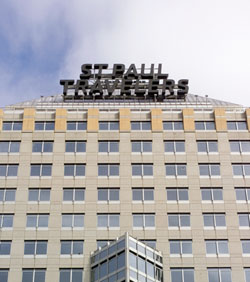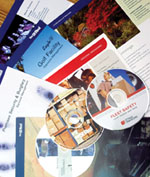
Marketing
Programs "r" us
St. Paul Travelers invites business from MGAs and retailers
By Phil Zinkewicz
 |
| Tracy Whiteley, CPCU, ARM, is Vice President of St. Paul Travelers’ National Programs, which targets entertainment, leisure, sports, service, and retail industries. In the entertainment area, the company insures television and movie productions, documentaries, industrials, commercials, and educational productions, as well as concert tours, theatrical productions, and musicians. |
WANTED! MGAs and retail agents who specialize in property and casualty program business. Must have risk management and loss prevention expertise. All programs will be considered.
That promotional announcement might very well be hanging in the windows of St. Paul Travelers these days. The company has been writing program business since 1980, having started modestly with a rental equipment program that is growing significantly. Today St. Paul Travelers boasts 110 programs across the company’s various business units, including small commercial Select National and Affinity Programs (SNAP), National Property and Inland Marine Specialty Commercial, Ocean Marine and, last but certainly not least, the National Programs Commercial Accounts Group.
Tracy Whiteley is vice president for National Programs, having responsibility for the overall leadership and management of program business within the company. She also oversees program underwriting best practices through the company’s Program Network, a joint effort among several business units. She joined St. Paul Companies—now St. Paul Travelers—in 1987 as an underwriting analyst in the Small Commercial Insurance Group, where she worked on all facets of product development. In 1991 she was a founder of the company’s Public Sector Services division and was instrumental in shaping that division’s strategy, overall direction and development. Whiteley was also part of The St. Paul’s Strategic Planning & Development unit, with responsibilities for merger and acquisition activity, strategic planning, and corporate strategy and development initiatives.
“Under National Programs, our products and services include guaranteed cost property and casualty coverages, tailored claims, risk control, audit and policy processing services, promotional and advertising assistance and pricing plans,” says Whiteley. “Our targeted industries are entertainment, leisure, sports, service and retail. A sampling of our programs includes Charity First, which includes arts, civic and social clubs and organizations, community development organizations, individual and family social services, residential-based programs and services, schools, education and training services. We also have programs for concrete pumpers, equipment rental operations, Girl Scouts, golf facilities, golf tournaments and related services, health and human services, landscapers and arborists, liquid propane distributors, movie theatres, national franchised truck dealers, ServiceMaster and structural movers.”
Know when to hold ’em
St. Paul Travelers’ approach to program business might be described as a “know when to hold ’em, know when to fold ’em” philosophy, which has stood the company in good stead. For example, in the entertainment area, the company writes television and movie productions, documentaries, industrials, commercials and educational productions, as well as concert tours, theatrical productions and musicians. The company was one of the first to insure reality television shows and is now one of the leading insurers of this type of entertainment. Risks in entertainment categories are budgeted for $15 million or less.
“The business was originally written through Encore Entertainment, an MGA in California, but it grew so rapidly that eventually it made more sense to acquire the MGA and bring its talent in house,” Whiteley says. “Now they are employees of St. Paul Travelers. They’re happy and we’re happy.”
 |
“We are always looking for new programs to bring under our roof. The merger between The St. Paul and Travelers has put us in a strong position to write new programs.”
—Tracy Whiteley |
Whiteley says that the entertainment program business received a big boost when The St. Paul and Travelers merged and, in 2004, the company brought Gulf Entertainment into the group, which had been part of Travelers. Because St. Paul Travelers had acquired the MGA, retail agents with entertainment business are now able to approach the company directly. Another program that retail agents can access directly is the company’s Eagle 3 program, which was started in the mid-1980s to write golf course and tournament business. All other programs are written through MGAs. “Initially, the Eagle 3 program was not particularly successful, so we decided to bring it in from our field offices and handle the business centrally in Atlanta. Now the program is extremely successful, and we have the endorsement of the PGA Tour,” Whiteley says.
However, there are times when St. Paul Travelers “knows when to fold ’em,” according to Whiteley. “We were looking for new ways to grow, so we started writing barricade rental operations, which rent items such as temporary cones and electronic signs for use on road construction sites,” she says. “We found we couldn’t make that work because the contractual language made it unfavorable from a legal and defense standpoint. We saw an increase in defense costs and found ourselves in situations where there was no clear liability, so we stopped writing this type of rental account.”
Sound risk management
Whiteley says that sound risk management techniques are important in all of the programs that St. Paul Travelers writes. For example, in the rental equipment area, the company’s program targets family-owned operators who rent to construction companies, contractors and homeowners who occasionally need to rent equipment such as forklifts, trailers, tents and chairs. “This is our oldest program and a quite successful one, so we decided to do a claims study to find out where losses occurred most frequently. We’ve done other studies since.”
According to the latest study, titled Renting Dangerously: Injuries, Fatalities and Losses in the Equipment Rental Industry, accidents associated with rental lifts were the leading cause of fatalities. Five of the 18 rental-equipment fatalities were attributed to personnel lifts. Of those fatalities, four involved power line contact. The study also found that personnel lifts also ranked No. 1 in severity, meaning lift accidents accounted for the highest costs of rental equipment insurance claims. Forklifts were responsible for four fatalities, with operator error being a factor in all four of these incidents. Trailers ranked No. 1 in total number of rental equipment and No. 3 in total claims costs. Damages and injuries related to tent rentals ranked No. 4 in terms of severity, according to the study.
“Rental equipment establishments should provide adequate training and safety information to consumers before renting to them,” says Whiteley. “As an insurance company, we’re always looking for ways to promote safety and minimize risk. We work with rental dealers to ensure that consumers are trained properly and are provided with information and resources that clearly explain how to use rental equipment safely.”
Whiteley cited the following case studies to demonstrate how fatalities, injuries and property loss can occur in the equipment rental industry:
• Lifts—Two workers were trying to measure spacing for roof purlins. One was situated on top of the building and the other in the lift. To measure the spacing, the worker on top of the building was holding on to one end of a metal tape measure, while the worker in the lift held the other end. The lift operator raised the platform to be even with the building and made contact with the overhead power line. This electrocuted both workers because the metal tape measure acted as a conductor. The electrocution knocked the worker on the building 20 feet to the ground and killed the individual who was in the lift.
• Forklifts—A worker drove a forklift a few miles down a road and hit a curb. The forklift rolled over and pinned the operator underneath. The forklift may not have had a safety belt, as a result of which the operator was thrown from the forklift. It also was alleged that the worker was not properly certified to operate a forklift.
• Tents—A rental customer rented some tents and wanted the rental company to set them up on the customer’s property. The customer did not want the tents to be staked into the ground. The rental company employees anchored the tents with weights instead, possibly going against the manufacturer’s recommendation and industry best practices. Wind knocked over two of the tents because of poor anchoring, causing property damage and injuring 10 people.
• Trailers—A man with a small truck rented a trailer and backhoe from a rental facility. He was assured that his truck was properly rated, or strong enough, to pull the load. The claimant was driving home when the trailer began to fishtail and he lost control. The trailer broke away from the truck and the truck rolled. The driver was unharmed, but a passenger—a child—was seriously injured in the accident.
 |
| St. Paul Travelers provides risk control training CDs to customers in addition to marketing materials. |
“These are just some examples of what can go wrong in the equipment rental industry,” says Whiteley. “We advise dealers to give their consumers well-documented operating instructions and to include large cautionary labels on rental equipment. Dealers should also inspect and service all rental equipment prior to each rental to ensure the equipment is in proper working condition. Whenever possible, old and out-of-date equipment should be replaced with new equipment that includes the latest industry safeguards. By taking a few simple precautions, rental dealers can mitigate risk and improve safety,” she says.
Whiteley says that the company is beginning a claims study of its Eagle 3 program as well. “The exposures under the golf program include property, bodily injury, slips and falls, among other things,” she says.
Sometimes St. Paul Travelers takes on new programs at the suggestion of MGAs or retail agents. “We started a structural movers program—people who move houses, but not contents—in 2004. That was the result of an agent who had a program in place with a competitor of ours, but approached us to take over the program because of our strong relationship with the agent. In 2003, we added two programs that were existing programs of competitors who withdrew from the market. We are always looking for new programs to bring under our roof. The merger between The St. Paul and Travelers has put us in a strong position to write new programs. We’re also looking for new MGAs and new retail agents to bring us business,” says Whiteley. *
For more information:
St. Paul Travelers
Web site: www.stpaultravelers.com